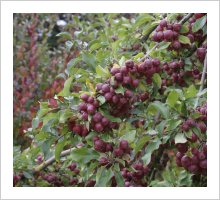Crab Apples for a Drought Tolerant Garden
I’ve got an enormous crop of crab apples on my three trees of Malus ‘Gorgeous’ this year. What I do with this abundance is make crab apple jelly which 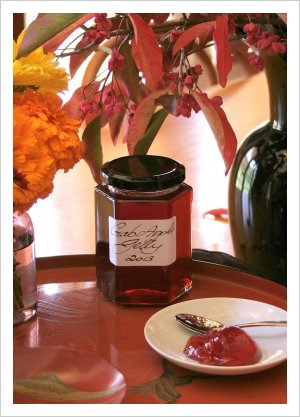 is one of the easiest of all jams to make as long as the fruit is simmered for a good while and then strained through muslin before adding the sugar.
is one of the easiest of all jams to make as long as the fruit is simmered for a good while and then strained through muslin before adding the sugar.
This is my method for making crab apple jelly:
Rinse the fruit in cold water to remove any bird poo.
Place the crab apples in a large stainless steel saucepan and cover with water.
Bring to the boil with the lid on and then turn the heat down to a simmer until fruit is soft and mushy and the liquid is flushed with the colour of the crabs. This will take an hour or two.
Pour the resulting liquid and fruit through a double thickness of muslin. The muslin should be rinsed in warm water and then scalded with boiling water beforehand.
Let the liquid pass through the muslin in its own time. Don’t squeeze the muslin to get the last bit of juice out as this will make the jelly cloudy.
Measure the volume of the liquid and it put back into a clean stainless steel saucepan and add the same volume of sugar as there is liquid. Boil briskly with the lid off the saucepan keeping an eye on it to make sure it doesn’t boil over.
Boil until setting point is reached. I don’t stir the liquid after the sugar has been dissolved and especially not when the setting point is close. The it is stirred the better the texture of the jelly.
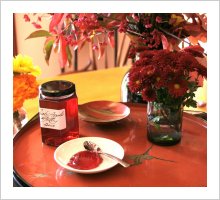 Before starting to make the jelly I put a few saucers in the freezer and when the jelly looks ready I take out a saucer and with a wooden spoon take some of the cooking jelly and put it on the cold saucer. After ten seconds or so I push the cold jelly with my finger. If it wrinkles it is set.
Before starting to make the jelly I put a few saucers in the freezer and when the jelly looks ready I take out a saucer and with a wooden spoon take some of the cooking jelly and put it on the cold saucer. After ten seconds or so I push the cold jelly with my finger. If it wrinkles it is set.
I pour the jelly into clean jars which have been sterilised in the oven at 120C for the time it takes to make the jelly. I pour boiling water over the lids, drain and dry with a clean tea towel. Very carefully, because the jelly is very hot, I put the lids on the jars and seal.
The rich, glossy, ruby red jelly is as delicious to look at as it is to eat. It has a good balance of sweet and tart.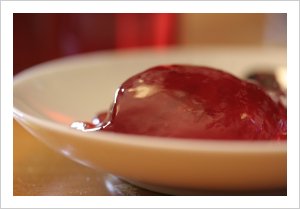
I grow a few varieties of crab apple in the garden. The most beautiful fruit are produced by Malus ‘Gorgeous’ and M. ‘Golden Hornet’.
M. x atrosanguinea ‘Gorgeous’ is a hybrid between two Japanese species, M. toringa (syn M. sieboldii) and M. halliana. It was raised in New Zealand by Haywood Wright and introduced into the nursery trade in 1925. There are three trees of this variety in the garden all top worked (grafted) onto 1.8 metre tall standards. In fifteen years they have made decent small trees some 5 metres tall by as much across. The white flowers are not the showiest in the genus but are attractive enough. This tree is really grown for its crimson fruit which are some 2.5cm diameter. As I write in the last days of April the tree is so heavy with fruit that it looks more like a weeping tree. All the branches are so bowed down. However the tree will spring back to shape when the fruit is picked.
Malus toringa ‘Golden Hornet’, an English raised seedling, was first released to the gardening public in 1949. I have one tree of this cultivar and it is planted and flourishes in a very difficult spot in the Dry Garde. After fifteen years it has made six metres in height and five metres in width. It’s quite showy as a blossom tree having pale pink buds opening to white flowers. During autumn lime-green crabs mature to rich yellow. It loses all of its leaves by early May and to see the golden fruit set against a clear autumn sky is a heart stopping experience.
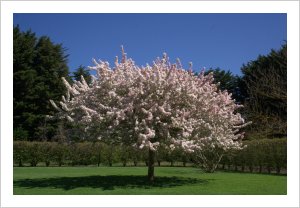 Malus floribunda is the most spectacular blossom tree of all in my garden. Top grafted on a 1.8 metre standard it has made a spreading small tree, 5 metres tall by 8 metres in diameter, in fifteen years. During early to mid-spring every branch is smothered with red buds which open to single white flowers. The small two toned, lime-yellow and old gold fruits, whilst not large, are jewel-like but nowhere near as showy as M. ‘Gorgeous’ or M. ‘Golden Hornet’.
Malus floribunda is the most spectacular blossom tree of all in my garden. Top grafted on a 1.8 metre standard it has made a spreading small tree, 5 metres tall by 8 metres in diameter, in fifteen years. During early to mid-spring every branch is smothered with red buds which open to single white flowers. The small two toned, lime-yellow and old gold fruits, whilst not large, are jewel-like but nowhere near as showy as M. ‘Gorgeous’ or M. ‘Golden Hornet’.
Crab apples are much easier to grow and need a lot less summer water than flowering cherries and happily flourish in the harsh climate of Central Victoria. Once established they can get by on just two or three supplementary waterings a year, even during such an extremely dry season as the latest one.
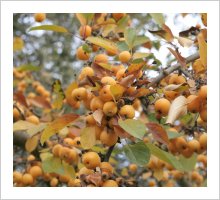 |
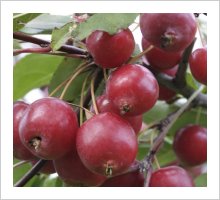 |
|
| Malus toringa ‘Golden Hornet’ | Malus 'Gorgeous' | Malus 'Gorgeous' |
